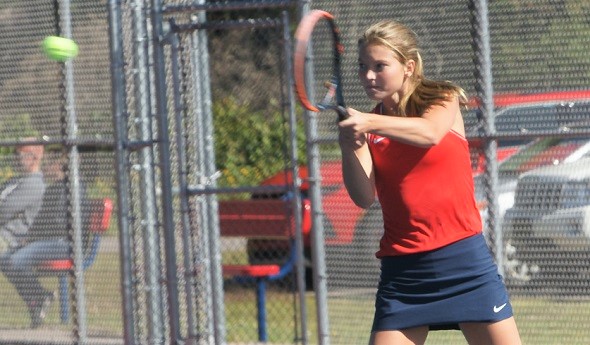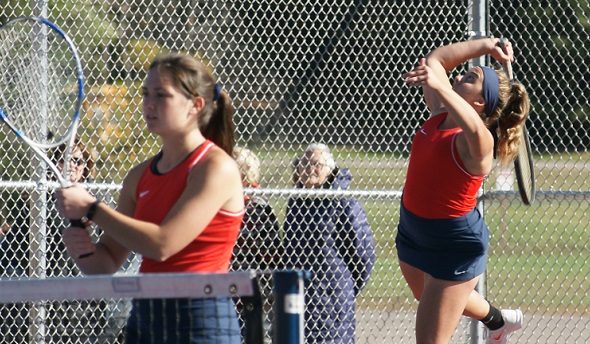
Westwood Adds 2 Titles to Successful Swing
October 16, 2019
By Geoff Kimmerly
Second Half editor
Dynasty and dominance too often are used to describe long-term success in sports. And assigning them to shorter-term accomplishments often takes away from teams that might be deserving of such high praise.
 But when it comes to Ishpeming Westwood tennis, there aren’t a lot of words to better explain the Patriots’ hold on Upper Peninsula Division 2 over the last 11 years.
But when it comes to Ishpeming Westwood tennis, there aren’t a lot of words to better explain the Patriots’ hold on Upper Peninsula Division 2 over the last 11 years.
The Patriots have won 10 Finals championships during that time, all but one outright. At this season’s MHSAA tournament, Westwood claimed six flight titles and finished runner-up at the other two. And this run was kicked off by another memorable accomplishment a week earlier – the taking back of the Mid-Peninsula Conference title after three straight years finishing runner-up to UPD1 power Negaunee.
The MHSAA/Applebee’s “Team of the Month” for September accomplished all of this under a first-year coach, but hardly a first-year contributor to the program. Sarah Massie was part of four Division 2 titles as a player from 2009-12, then spent summers home from college giving clinics and private lessons to players who now fill her lineup. She watched the success from afar while getting her teaching and coaching start at Kingsford, then returned to her alma mater this fall to take over for mentor Chris Jackson, who remained her assistant and had coached the Patriots to nine of their 14 Finals titles.
“It’s pretty much a continuing of what I already knew and what I knew worked,” Massie said. “I will try different things. But as far as the program in general, I was there as Chris was building it. Whether I was playing in the program or helping out with the program, I was there for the whole process – and that definitely helped.”
A lot goes into Westwood’s annual success. But it’s fair to say it starts with attitude and perspective, which leads to incredible participation.
The program had 37 athletes this fall – which would be 20 percent of the girls in the high school if compared to its 2018-19 enrollment.
“We encourage the girls to come out, but we also have the attitude of tennis is fun,” Massie said. “It's a lifelong sport. It's great to learn it in high school so you can play it forever. The girls that want to get better and want to invest that time, that's what these coaches are here for and we encourage that and we help bring them to their next level.
“That attitude encourages a lot of girls to play. Keeping the numbers up is definitely what helps us be successful every year. We’re competitive with other teams because we’re competitive within our lineup.”
 A league title generally ranks a bit lower than something won state or peninsula-wide. But in this case, claiming the MPC title had to come close in significance: Negaunee went on to finish runner-up in UP Division 1 this fall after winning that championship five straight seasons.
A league title generally ranks a bit lower than something won state or peninsula-wide. But in this case, claiming the MPC title had to come close in significance: Negaunee went on to finish runner-up in UP Division 1 this fall after winning that championship five straight seasons.
Westwood had split with the Miners in a pair of duals leading up to the league tournament Sept. 26.
“We played them our first meet of the year, and you could just tell that it wasn’t (that our team) had gotten beaten by Negaunee every year so they were scared to play them. It was, ‘I want to play them. I want to beat them. I want to play them again,’” Massie said.
“The best part of MPCs was when the day started, we knew we could win and we knew Negaunee could win. So there wasn’t the pressure of ‘we are supposed to win this,’ and also not the downfall of ‘Negaunee should win this.’ We came into the day (saying) we have no idea what’s going to happen, but we know we can win. So let’s just play our best, worry about the things we can control, and see what happens.”
After winning that first match against Negaunee this fall 5-3, the Patriots fell in the rematch by the same score. The two teams played in the championship match at every flight at the league tournament, with Westwood coming out on top 6-2.
That served as a preview of the UPD2 Final a week later, where the Patriots also won six flights and finished runner-up at the other two.
At both the league and Finals tournaments, Madi Koski (No. 1), Tessa Leece (2), Jillian Koski (3) and Jenna Wealton (4) swept singles championships. No. 3 doubles Avery Mariuzza and Emily Nelson also won at both the league and Finals events, while No. 4 Claire Gilles and Natalie Prophet was a Finals champ and No. 2 Elle Miller and Meghan Johnson won at the MPCs. Top doubles pair Katelyn Antilla and Karlie Patron finished runner-up at both tournaments.
No flight finished undefeated this fall, but none suffered more than four losses. Leece was 16-1 and Wealton 18-1 and avenged her only defeat, while Madi and Jillian Koski both finished 16-3. Miller and Johnson at No. 2 doubles finished 17-2, their only losses both to the pair from West Iron County. As a team, Westwood’s only other defeat came to Marquette, the eventual Division 1 champion.
This had been the dream for Massie, who once she decided to go into education knew that returning to Westwood would be her ultimate goal. As an athlete for the Patriots she won No. 2 and No. 4 singles titles and finished runner-up twice at No. 1. Now she’s 1-for-1 leading the program to the top team accomplishment – and with that league title an added bonus on which to build in the future.
“It seems every year we end up with a good group of girls who are fun to coach,” Massie said. “We had five seniors in the varsity lineup, and they were all great kids and fun to be around, and hard workers.”

PHOTOS: (Top) Westwood’s Tessa Leece returns a volley during a No. 2 singles match this season. (Middle) Katelyn Anttila and Karlie Patron serve during a No. 1 doubles match. (Below) The Patriots celebrate their latest Upper Peninsula Division 2 championship. (Photos courtesy of the Westwood girls tennis program.)

Michigan's Most Vital Prep Sports Moment
April 30, 2018
By Ron Pesch
Special for Second Half
Did you ever hear the one about an Ypsilanti lawyer, two girls from Ann Arbor – one 18 and one 17 – and a judge from Detroit?
I didn’t think so.
Well, pull up a chair. You might never look at a tennis ball, a pair of track cleats, or a softball in the same manner after this one.
Now this story goes back a bit. We’re talking 45, um, make that 46 years ago. It was handed down to me, so now I’m handing it down to you.
The girls, Cindy and Emily, had met at a tennis club when they were 11 or 12. Both were pretty good players who had done well at tennis tournaments before heading off to Huron High School. But there was concern that the girls wouldn’t have the chance to play truly competitive tennis while in high school. You see, like most public schools of the time, Huron had only one varsity tennis team, and that was filled with boys.
Contact was made with a friend and fellow tennis player to help guide things along when it came time to talk to the school board about the girls joining that team.
The conversation between that tennis friend – Larry the Lawyer – and the school board went pretty well. The board decided to let the girls play on the boys tennis team provided they could pass the tryouts. Well, as you’ve probably surmised, the girls did all right. With the blessing of Coach Jerry, it was decided Cindy and Emily would play No. 2 doubles for the River Rats.
 But as we all know, such decisions aren’t always met with cupcakes being served and happiness. People don’t always like change.
But as we all know, such decisions aren’t always met with cupcakes being served and happiness. People don’t always like change.
And that was pretty much the case here.
State officials didn’t much care for the idea. You see, when it came to interscholastic athletics, according to state rules established in 1967, girls couldn’t play on boys teams. Still, the Huron tennis team made the 60-mile trip up to Lansing on a Wednesday in April for a match with Lansing Harry Hill High School. Coach Jerry met with Hill’s coach, they shook hands, then Coach Jerry turned in his line-up card, to make things orderly and official.
Since there were girls names on the lineup card, not a single ball was served that day. Folks figured this was going to be the case. So the players and the bus turned around and headed back to Ann Arbor. Hill claimed a forfeited match because of that rule.
That set wheels in motion. Larry the Lawyer declared that this was a clear case of discrimination and a violation of Cindy and Emily’s right to equal protection under the 14th Amendment. With that, a lawsuit quickly was filed.
Now, they say that this was one of the first, if not the first lawsuits about such things. And you must remember this all happened back in early 1972, before the arrival of Title IX.
Turns out, Larry and the girls won their case. In Federal District Court, Judge Keith listened to what was said and issued a preliminary injunction allowing the girls to play. A little later in the week, Emily and Cindy won their first varsity doubles match hosted in Battle Creek, much to the dismay of their male opponents.
 The next month, the Michigan Legislature adopted a bill allowing girls to compete on male teams, but only in non-contact sports. In late May, the doubles team of Emily and Cindy defeated a doubles team from Harry Hill, 6-3, 6-1.
The next month, the Michigan Legislature adopted a bill allowing girls to compete on male teams, but only in non-contact sports. In late May, the doubles team of Emily and Cindy defeated a doubles team from Harry Hill, 6-3, 6-1.
Of course, as with many of these rulings, there was an appeal. And, as these things usually do, it took a while to move this along. But come January 1973, the U.S. Circuit Court down in Cincinnati agreed with Judge Keith and upheld the preliminary injunction. They, too, thought that girls should be able to participate in varsity interscholastic sports. The Circuit Court did narrow Judge Keith’s decision a bit, inserting the word “NON-CONTACT” into the ruling. Suddenly, it was officially OK for girls to play alongside the boys in sports like tennis, swimming, archery, golf, bowling, fencing, badminton, gymnastics, skiing, and track and field.
Now just because there’s a law, it doesn’t mean everyone’s abiding by it. It would take several more years and the threat or the filing of additional lawsuits against school districts and organizations to truly see things change.
Today, we don’t think twice when we take a seat at a girls softball game, track meet or tennis match. But a short time ago, such things simply did not exist for our daughters. The actions of two girls from Ann Arbor, an Ypsilanti lawyer and a judge from Detroit altered the athletic world – for the better.
 Lawrence Sperling’s lawsuit to support Cindy Morris’ and Emily Barrett’s quest to play high school sports was certainly a highlight of his career as an attorney. Lawrence and his wife Doris had sons who were outstanding tennis players. Michael and Gene were high-ranking players at Ann Arbor Pioneer during the 1970s. Gene played four years of tennis at the University of Minnesota and would later serve as Director of the National Economic Council and Assistant to the President for Economic Policy under Presidents Bill Clinton and Barack Obama. In 2012, he would write about his father and the landmark case for the White House.
Lawrence Sperling’s lawsuit to support Cindy Morris’ and Emily Barrett’s quest to play high school sports was certainly a highlight of his career as an attorney. Lawrence and his wife Doris had sons who were outstanding tennis players. Michael and Gene were high-ranking players at Ann Arbor Pioneer during the 1970s. Gene played four years of tennis at the University of Minnesota and would later serve as Director of the National Economic Council and Assistant to the President for Economic Policy under Presidents Bill Clinton and Barack Obama. In 2012, he would write about his father and the landmark case for the White House.
 Judge Damon Keith had been appointed to the bench of the United States District Court for the Eastern District of Michigan by President Lyndon Baines Johnson, in 1967. It was some four and a half years later that the Morris-Barrett complaint landed on his docket. A graduate of Detroit Northwestern High School, he is the father of three daughters. Keith would later be appointed to the United States Court of Appeals for the Sixth Circuit Court in Cincinnati by President Jimmy Carter in 1977. In 1995, he became the Senior Judge of that court. His amazing story was later told in a documentary “Walk With Me: The Trials of Damon J. Keith.”
Judge Damon Keith had been appointed to the bench of the United States District Court for the Eastern District of Michigan by President Lyndon Baines Johnson, in 1967. It was some four and a half years later that the Morris-Barrett complaint landed on his docket. A graduate of Detroit Northwestern High School, he is the father of three daughters. Keith would later be appointed to the United States Court of Appeals for the Sixth Circuit Court in Cincinnati by President Jimmy Carter in 1977. In 1995, he became the Senior Judge of that court. His amazing story was later told in a documentary “Walk With Me: The Trials of Damon J. Keith.”
According to media reports, Coach Jerry Shull had been trying to get girls eligible for the previous two seasons, but felt the ultimate solution was to have high schools around the state form all-girls varsity teams. He again served as varsity tennis coach in 1973 (of a team that featured 10 females) before stepping aside in 1974.
 Emily Barrett was a multi-sport athlete at Huron High School, competing with the Girls Athletic Club in swimming, field hockey and volleyball as well as tennis during this era of transition. During her senior year, the courts finalized their decision and she again played tennis for Huron. She’d move on to Denison University in Granville, Ohio, after graduation, where she played tennis and field hockey.
Emily Barrett was a multi-sport athlete at Huron High School, competing with the Girls Athletic Club in swimming, field hockey and volleyball as well as tennis during this era of transition. During her senior year, the courts finalized their decision and she again played tennis for Huron. She’d move on to Denison University in Granville, Ohio, after graduation, where she played tennis and field hockey.
A year older than Barrett, Cindy Morris had graduated from Ann Arbor Huron High School by the time the case was finalized. She headed off to the University of Michigan and then transferred to Carleton College in Northfield, Minnesota, where she played No 1. singles and doubles and twice participated in the National Collegiate Women’s Tournament. She later earned her Master’s degree in journalism from Northwestern University. As Cindy Morris, a sports journalist for the Cincinnati Enquirer, she recalled the words of Judge Keith for an article she was writing in late summer of 1978.
“Indeed, no male could have matched (the) soprano cries of joy when Judge Keith said, yes, go out and run and play and win and lose and laugh and cry and feel that special pride of playing for your school that boys in Michigan have always felt but you haven’t.”
The article was about a lawsuit originating in Yellow Springs, Ohio, where a girl was fighting to be allowed to compete in contact sports against boys.
 Ron Pesch has taken an active role in researching the history of MHSAA events since 1985 and began writing for MHSAA Finals programs in 1986, adding additional features and "flashbacks" in 1992. He inherited the title of MHSAA historian from the late Dick Kishpaugh following the 1993-94 school year, and resides in Muskegon. Contact him at [email protected] with ideas for historical articles.
Ron Pesch has taken an active role in researching the history of MHSAA events since 1985 and began writing for MHSAA Finals programs in 1986, adding additional features and "flashbacks" in 1992. He inherited the title of MHSAA historian from the late Dick Kishpaugh following the 1993-94 school year, and resides in Muskegon. Contact him at [email protected] with ideas for historical articles.
PHOTOS: (Top) The first high school match in 1972 for Ann Arbor Huron's Emily Barrett, left, and Cindy Morris was reported on for the Battle Creek Enquirer. (Top middle) The 1972 Ann Arbor Huron varsity tennis team, including Morris and Barrett. (Middle) The Ann Arbor Huron lineup card shows Barrett and Morris' names for a match against Lansing Harry Hill that was not played. (Below) A Lansing State Journal clipping tells of Hill electing to not play the match.

